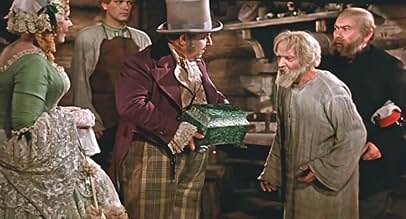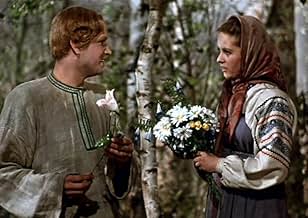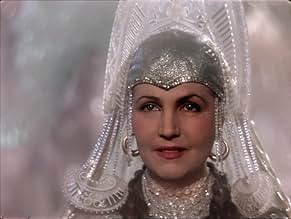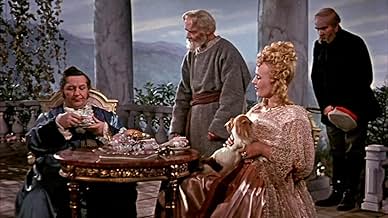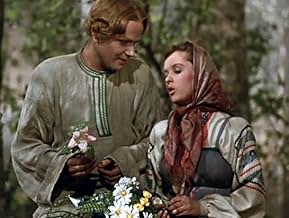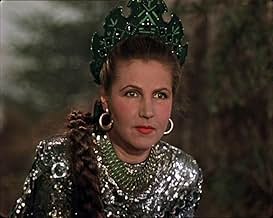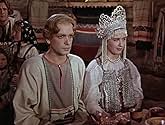IMDb-BEWERTUNG
7,1/10
559
IHRE BEWERTUNG
Füge eine Handlung in deiner Sprache hinzuObsessed with perfecting his craft, young gemcutter Danilo visits the mystical Copper Mountain to uncover the secret behind its infamous attraction - the Stone Flower, a stone carving so cap... Alles lesenObsessed with perfecting his craft, young gemcutter Danilo visits the mystical Copper Mountain to uncover the secret behind its infamous attraction - the Stone Flower, a stone carving so captivating that no one can leave after seeing it.Obsessed with perfecting his craft, young gemcutter Danilo visits the mystical Copper Mountain to uncover the secret behind its infamous attraction - the Stone Flower, a stone carving so captivating that no one can leave after seeing it.
- Regie
- Drehbuch
- Hauptbesetzung
- Auszeichnungen
- 2 Gewinne & 2 Nominierungen insgesamt
Vladimir Druzhnikov
- Danilo - master
- (as V. Druzhnikov)
Yekaterina Derevshchikova
- Katya
- (as Y. Derevshchikova)
Mikhail Troyanovskiy
- Prokopych
- (as M. Troyanovsky)
Mikhail Yanshin
- Severyan
- (as M. Yanshin)
Nikolay Temyakov
- Barin
- (as N. Temyakov)
Anna Petukhova
- Barina
- (as A. Petukhova)
Nikolai Orlov
- Stary master
- (as N. Orlov)
Lidiya Deikun
- Vikhorika
- (as L. Deikun)
Serafim Zaytsev
- Yefimka
- (as S. Zaytsev)
Vitaliy Kravchenko
- Danilo - malchyk
- (as V. Kravchenko)
Empfohlene Bewertungen
This faux (?) folktale, probably the best known film of Soviet fabulist Aleksandr Ptushko, is a paean to artistic individuality: a daydreaming youth becomes protégé to an old stone carver; visits the secret cave of a mountain witch to delve into his art; and then, with the unwavering trust of his deserted bride, finds his way back into the world as absolute master of his craft. A rather non-collective idea to find in the Stalinist film world of the time. Ptushko's style often looks like some over-decorated/Russian-themed Christmas window, but it certainly fits his subject. The crudity in the technique comes off as sincerity and the USSR color processing of the era is often quite lovely if you boost the brightness level on your equipment. Aimed at kids, but probably best for grown up cultural Sovietologists.
NOTE: Check out the DVD extras for an amazing stop-motion animation clip from Ptsuhko's 1936 pic THE NEW GULLIVER.
NOTE: Check out the DVD extras for an amazing stop-motion animation clip from Ptsuhko's 1936 pic THE NEW GULLIVER.
The Stone Flower as a piece of cinematic art, seems to surpass Disney, or The Wizard of Oz, in a similar visual vein, and always clearly presents it's own unique impeccable, and intricate attention to delicate detail, not found in many other films.
There is a pleasing sense of welcoming and invitingness to the film, and with kindness and gladness it opens itself up to you to come along and enjoy.
Great care, classiness, and refinement abound in the production of The Stone Flower, and it makes for a beautiful experience to watch. And whether you can understand Russian, or not, visually the story will keep it's pace, and lead the way for you quite clearly.
The Stone Flower is a tale of folk, and a tale of beautifulness and happiness, and it is sprinkled in the icing sugar of magicalness, and fantasy!
A very lovely film! :)
There is a pleasing sense of welcoming and invitingness to the film, and with kindness and gladness it opens itself up to you to come along and enjoy.
Great care, classiness, and refinement abound in the production of The Stone Flower, and it makes for a beautiful experience to watch. And whether you can understand Russian, or not, visually the story will keep it's pace, and lead the way for you quite clearly.
The Stone Flower is a tale of folk, and a tale of beautifulness and happiness, and it is sprinkled in the icing sugar of magicalness, and fantasy!
A very lovely film! :)
For the commentator below, I thought I had seen it on tape but I'm not sure. Most probably saw it an art house in Chicago or some university festival (Roosevelt University had a very good one back then).
The film's use of color was a landmark breakthrough. It was a process different and superior to technicolor. We can do it today in say, Kodacolor, and "The Red Shoes" did indeed quite approximate it but good as that was, it did not equal SF,
I wonder if Martin Scorcese, who did a commentary for "The Red Shoe" saw it. I'm sure he would have been impressed and if someone could get to him today he might even promote putting it on DVD just for gras artis gras.
The film was of some importance politically too in that it was the first kind of cultural exchange gesture the Soviets made at the height of the cold war. We probably sent them "Gone With The Wind." I mean that.
The film's use of color was a landmark breakthrough. It was a process different and superior to technicolor. We can do it today in say, Kodacolor, and "The Red Shoes" did indeed quite approximate it but good as that was, it did not equal SF,
I wonder if Martin Scorcese, who did a commentary for "The Red Shoe" saw it. I'm sure he would have been impressed and if someone could get to him today he might even promote putting it on DVD just for gras artis gras.
The film was of some importance politically too in that it was the first kind of cultural exchange gesture the Soviets made at the height of the cold war. We probably sent them "Gone With The Wind." I mean that.
I saw The Stone Flower as somebody who really liked some of Aleksandr Ptusko's other films like Ruslan and Ludmilla, Sampo and Sadko(which is only to be seen in the original Russian version, the dub ruins it), and is having a great run of Russian fairy/folk-tale films. It was also highly recommended by commentators for those respective films, regarding it as one of his best/one of their favourites of his. I am happy that there are people who remember The Stone Flower very fondly, I am one of those newly-acquainted with it from Youtube rather than those who saw it in childhood. I am also glad that I saw it, as it really is as good as people say it is, and for me it is one of Ptushko's best. It is a gorgeous film to look at, the scenery is enough to take your breath away and the film is beautifully shot as well. It is very easy to be taken by the music score as well, because it does have a sense of fantasy and adventure, it sounds very Russian in its songs and its nationalistic feel, it is lusciously orchestrated and sometimes even sounds like a tender tone poem. The dialogue is well-incorporated within the story and sounds generally natural and sincerely delivered. The story is a magical one, it unfolds beautifully and packs a very powerful punch. It does move slowly particularly in the middle, but that is not a bad thing, if anything it gave the story a sense of freedom, time to breathe and allowed us to become invested in the characters and story and also admire the Russian culture. The characters all engage, especially the wicked Copper witch, they are fairy-tale clichés certainly but that is not to be taken as a bad thing. The acting is good, the hero is noble and sincere and the Copper Witch is both entrancing and icy. I personally didn't see the ending as that much of a cheat, there have been far worse ending cheats around. Though I do think also that The Stone Flower perhaps could've been even more powerful if ended tragically. All in all, magical. 10/10 Bethany Cox
An old man recounts a fairy-tale to a group of children about a stone-cutter, "Danila", who strives for perfection and meets with the mystical "Queen of Copper Hill". She asks him to sacrifice himself and remain with her in her unreachable world of stone at the expense of his married life with "Katinka", the girl he loves and whom he has just married.
The film is made in colour which is refreshing for 1946 and it is 15 minutes longer than described on IMDb. However, the story drags. The Russian hierarchy is very effectively captured - we witness the cruelties of the ruling classes who take to flogging the poor. They don't just flog them, they beat them to death for not working hard enough or not finishing a piece of work in time. Danila's talent at stone sculpture results in him being commissioned to make a piece for a wealthy landowner who wants to show off. However, the "Queen of Copper Hill" intervenes. It takes ages for this part of the story to get going, though.
Vladimir Druzhnikov is good in the lead role as "Danila". He looks a bit gay and girlie and very much suits the artistic type that is required for the film. The sets within the world of stone in Copper Hill are interesting in a "Star Trek" kind of way but each section of the film just seems to drag on for too long. Apart from the dance sequence in the wedding episode - one of the more entertaining parts of the film.
I also felt that the ending of the film could have been better. It's a happy-ending story but it would have been far more effective as a tragedy. We are led to believe that the Queen of Copper Hill has an evil sacrifice up her sleeve and that someone is going to get turned to stone for eternity. This is exactly what the film needs. But it doesn't happen. She suddenly switches to a goodie and we get a "love conquers all" message which is a disappointment. The film keeps you watching with false expectations and I felt cheated at the end. The rules suddenly change from "You can never go back!" to "Ok you can go back now". Very lame. The film needed an effective finale, ie, some tragedy, to redeem the rest of the tedious film but it didn't happen. It scores for novelty value only.
The film is made in colour which is refreshing for 1946 and it is 15 minutes longer than described on IMDb. However, the story drags. The Russian hierarchy is very effectively captured - we witness the cruelties of the ruling classes who take to flogging the poor. They don't just flog them, they beat them to death for not working hard enough or not finishing a piece of work in time. Danila's talent at stone sculpture results in him being commissioned to make a piece for a wealthy landowner who wants to show off. However, the "Queen of Copper Hill" intervenes. It takes ages for this part of the story to get going, though.
Vladimir Druzhnikov is good in the lead role as "Danila". He looks a bit gay and girlie and very much suits the artistic type that is required for the film. The sets within the world of stone in Copper Hill are interesting in a "Star Trek" kind of way but each section of the film just seems to drag on for too long. Apart from the dance sequence in the wedding episode - one of the more entertaining parts of the film.
I also felt that the ending of the film could have been better. It's a happy-ending story but it would have been far more effective as a tragedy. We are led to believe that the Queen of Copper Hill has an evil sacrifice up her sleeve and that someone is going to get turned to stone for eternity. This is exactly what the film needs. But it doesn't happen. She suddenly switches to a goodie and we get a "love conquers all" message which is a disappointment. The film keeps you watching with false expectations and I felt cheated at the end. The rules suddenly change from "You can never go back!" to "Ok you can go back now". Very lame. The film needed an effective finale, ie, some tragedy, to redeem the rest of the tedious film but it didn't happen. It scores for novelty value only.
Wusstest du schon
- VerbindungenFeatured in Good Bye, Sowjetunion! (2021)
Top-Auswahl
Melde dich zum Bewerten an und greife auf die Watchlist für personalisierte Empfehlungen zu.
Details
- Laufzeit1 Stunde 29 Minuten
- Sound-Mix
- Seitenverhältnis
- 1.37 : 1
Zu dieser Seite beitragen
Bearbeitung vorschlagen oder fehlenden Inhalt hinzufügen

Oberste Lücke
By what name was Die steinerne Blume (1946) officially released in Canada in English?
Antwort
